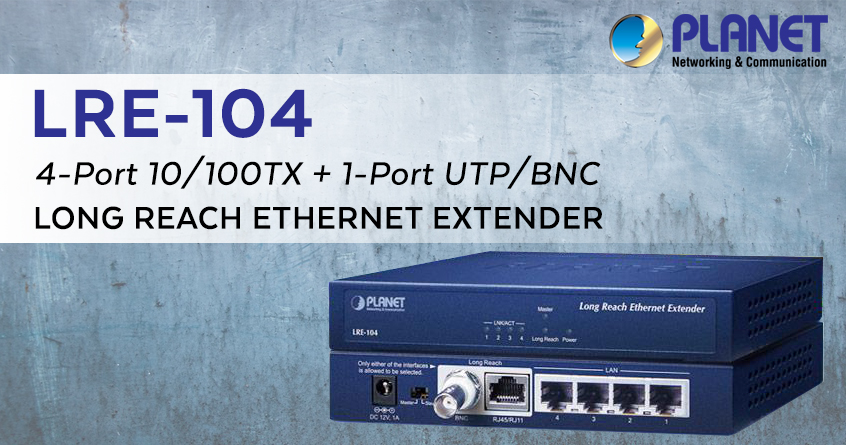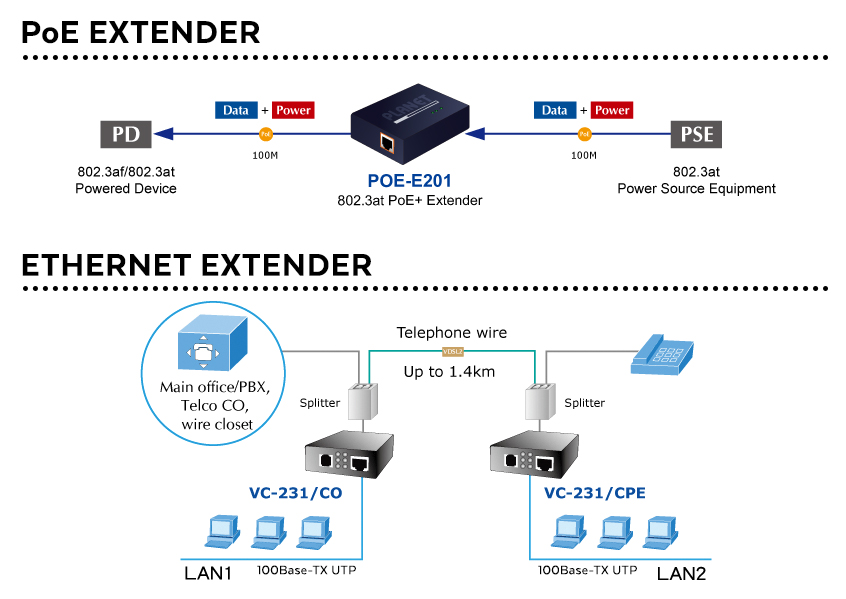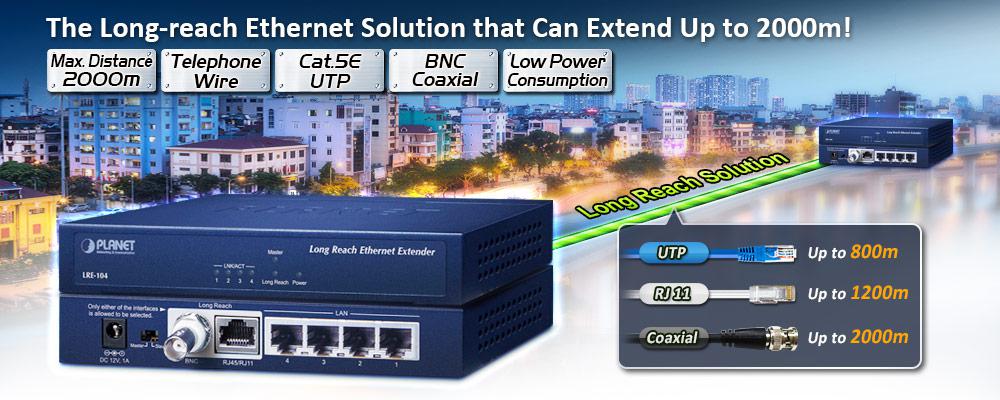Not long ago, it was commonplace for computers and other devices to connect to networks through Ethernet ports, switches, and extenders. In recent years, however, connecting to a network often begins with the user receiving a request for a WiFi password. Though WiFi is the experience end users see from their perspective, Ethernet is still very much in play. Ethernet continues to hold its own when it comes to reliability, consistent connection speeds, and ease of use when connecting to a network. Most serious systems depend on Ethernet as their workhorse for a variety of functions. From connecting computers to a server, adding CCTV or security features, and even connecting WiFi ports to the main network, a functional network relies on Ethernet. An Ethernet extender allows network designers to push the limitations of standard cabling while still preserving signal strength and without compromising consistency.
Basics of Ethernet
To understand what an Ethernet extender does, it is important to know some of the basics of what Ethernet is. Ethernet is a communication protocol that provides the means for, as well as a system of rules to govern, communications between systems, within a network. This standard protocol allows a wide range of manufacturers to build components, hardware, and software to communicate with each other in a network. These rules also allow local area networks and wide area networks to essentially speak the same language, and share consistent transmission methods and data transfer rates while also reducing errors and data corruption. Without these protocols in place, it would be like building a subway in a city without connecting all of the tracks or adhering to any standard practices, building codes or train sizes.
The binary language of your computer and other devices requires that their signals be carried on electrical signals at certain frequencies. Fiber optics transmit these signals over extreme distances through glass conduits with minimal data loss and nearly instantaneous transmission speeds. For local area networks, fiber optics can be expensive, difficult to protect from damage when installed in tight areas, and simply unnecessary compared to Cat5e and Coaxial cabling solutions. Copper cabling still has its limitations, with 10mbps speeds degrading significantly when passed beyond a length of 1,000 meters on twisted pair Cat5e cables or 1500 meters when using coaxial. Adding switches, ports, and other pieces of hardware into the mix will also reduce the quality of the electrical signal over time. Ethernet extenders, however, repeat a signal and thus, can extend the range of Ethernet without compromising signal integrity.
What is an Ethernet Extender?
Ethernet extenders are also known as repeaters. They take the signal which is being transmitted through the cabling, duplicate it, and broadcast that duplication down the next section of cable. This preserves the quality of the signal and produces negligible delays in data transmission. The strength of the signal remains strong and allows for other ports, switches, and systems units to communicate without interference. When data integrity, speed, and quality of transmission are crucial, Ethernet is still the gold standard networking protocol. Unlike Wifi systems where signals can degrade, be corrupted due to interference, or pose a security risk due to signal interception, serious networking must rely on Ethernet.
Some typical uses of Ethernet include the following:
- Local Area Networks (LAN)
- Security cameras
- WiFi access points
- Manufacturing fabricators
- 3D printers
- CNC machines
- Medical equipment
- Remote surgical systems
- Banking and finance computing
- Records archives and imaging processes
How Does an Ethernet Extender Differ from a PoE Extender?
Ethernet extenders primarily focus on extending network connectivity over longer distances. When powered devices are added into the system, Power over Ethernet (PoE) extenders perform the role of both network transmission extension and power delivery using a single Ethernet cable. The choice between the two depends on the specific requirements of the network installation, such as the need for power delivery to remote devices or the distance of the network extension.
The PLANET LRE-104 4-Port 10/100TX + 1-Port UTP/BNC Long Reach Ethernet Extender
The Planet Technology Long Reach Ethernet Extender is a versatile, powered repeater device that incorporates a variety of features and functions that can benefit your network. The metal housing provides durable protection and modular installation capabilities. It weighs 347g and with a relatively small profile of 154.6 x 86.0 x 26.3 mm, can be installed just about anywhere along your network.
- Ports: Four (4) 10/100 BASE TX ports, One (1) UTP JR45/BCN female port (w/metal housing)
- Type of Connectors: RJ-45 Ethernet connectors for use with Cat5e cabling and above
- Plug and play functionality: Reduces network downtime during installation and maintenance
- Temperature range for operation: 0-50°C. Operating humidity is 5~95% (without visible condensation)
- Frame size: 1522 bytes
- Long Reach Standard for Ethernet: IEEE 1901
- Compliance Standards: IEEE 802.3/802.3u Ethernet standard, IEEE 802.3x Full-duplex control standards, and IEEE 802.1q VLAN transparent
- Distance intervals: 100 meters of cable between repeaters (max)
- Power supply: 12V DC, 1 amp external power for use in 120v power systems
- LED status indicator lights: Know what is happening for diagnostics at a glance
- Compliant with TAA specifications and FCC Part 15 Class A and CE compliant
Where Can Ethernet Extenders Be Used?
Ethernet extenders have a wide range of practical applications. Here are some of the most common scenarios where an extender can be effective:
- VoIP phone networks
- IP video
- CCTV systems in roadside sensors
- Municipal transportation communication hubs
- Remote campus classrooms/Academic and K-12
- Commercial buildings, casinos, municipal buildings
- Banks and financial institutions
- Apartment complexes/rental properties
- Factory floors for automation enablement (UTP)
- Network retrofits to connect existing analog devices
- Transportation systems
- Metering systems
- Outdoor Wi-Fi access points
Choosing the Right Ethernet Extender for Your Network
Ethernet protocol has been around for decades, and many companies have flooded the market with switches, extenders, and other protocol-compliant hardware. Typically you will get what you pay for, and Information Technology always comes with the necessity of making systems hardware and software upgrades to stay ahead of the performance curve. Choosing an Ethernet extender such as the Planet Technology LRE-104 will give your network the versatility and performance it needs, along with the durability and functionality you can rely on. Planet Technology USA meets the price point most are looking for without sacrificing quality or performance at any point in the life cycle of our products.


